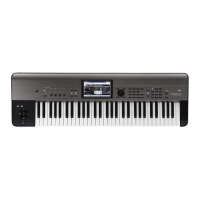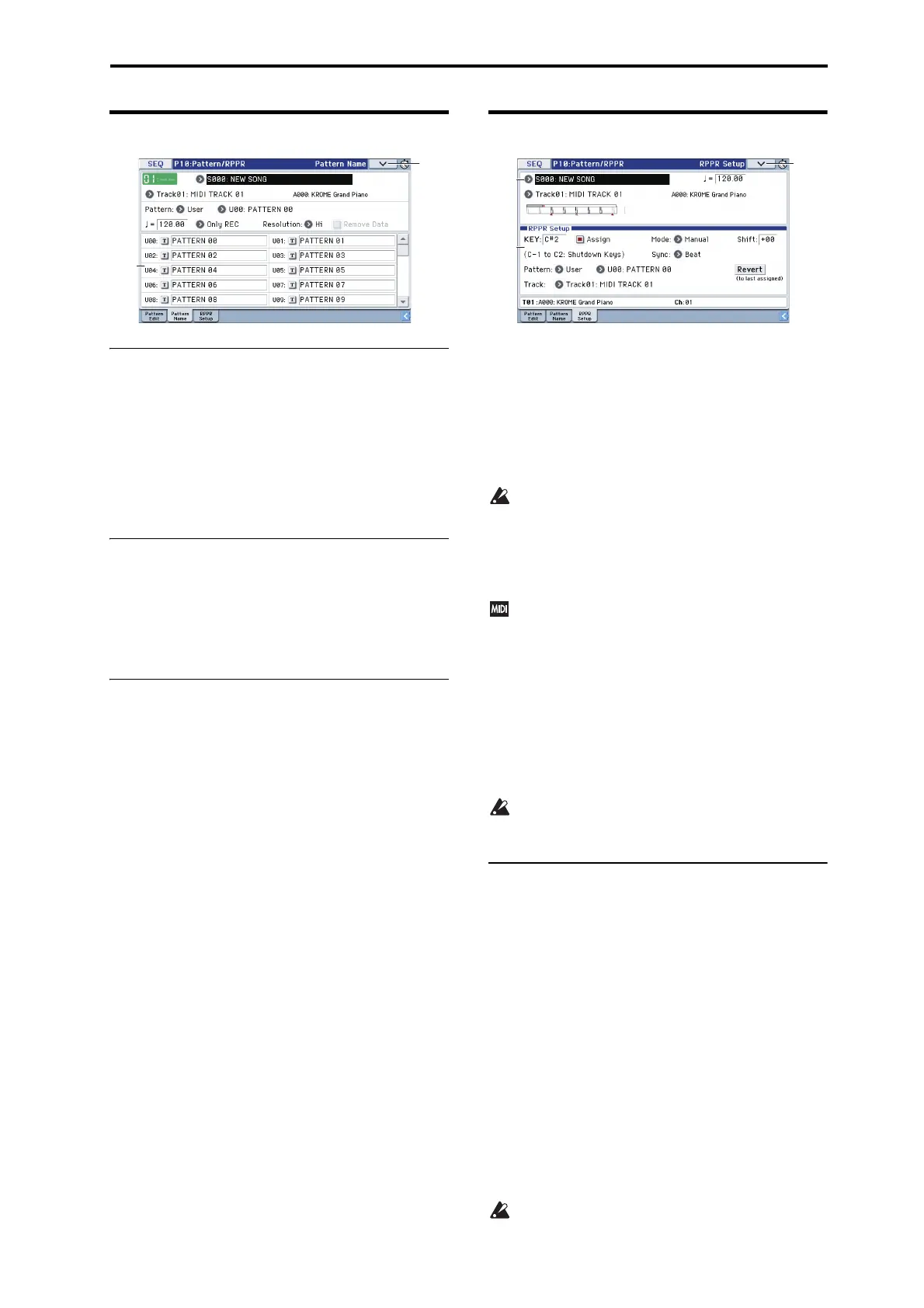SEQ P10: Pattern/RPPR 10–2: Pattern Name
157
10–2: Pattern Name
10–2a: Location, Song Select, Track
Select
10–2b: Pattern, Pattern Select, Tempo,
Metronome, Reso, Remove Data
For more information, please see “10–1a: Location, Song
Select, Track Select” on page 155 and “10–1b: Pattern
(Pattern Bank), Pattern Select, Tempo, Metronome, Reso,
Remove Data” on page 155.
10–2c: User Pattern Names
Pattern name [U00...U99]
Here, you can rename the pattern. Press the text edit button
to open the dialog box, and input the name. You can enter
up to 24 characters. See “Editing names” on page 117 of the
Operation guide.
V
10–2: Menu Command
• 0: Memory Status see p. 163
• 1: Exclusive Solo see p. 64
• 2: Step Recording (Loop Type) see p. 186
• 3: Event Edit see p. 169
• 4: Piano Roll see p. 186
•5: Pattern Parameter see p. 186
•6: Erase Pattern see p. 186
•7: Copy Pattern see p. 186
•8: Bounce Pattern see p. 187
•9: Get From Track see p. 187
•10: Put To Track see p. 187
• 11: Copy To Track see p. 188
• 12: Convert to Drum Trk Pattern see p. 188
• 13: Load Drum Track Pattern see p. 188
• 14: Erase Drum Track Pattern see p. 189
• 15: FF/REW Speed see p. 164
For more information, please see “Sequencer: Menu
Command” on page 163.
10–3: RPPR Setup
Here, you can adjust the settings for the RPPR (Realtime
Pattern Play/Recording) function. RPPR lets you assign
patterns to individual keys, and then play back patterns
simply by pressing individual notes on the keyboard. This
performance can be recorded in real‐time.
For each song, you can assign either a preset pattern or a
user pattern to each of the 72 keys in the range C#2–C8. For
each key, you can specify the pattern, track number, and
how the pattern will be played.
Keys used to play patterns via RPPR cannot be used for
the arpeggiator. If RPPR is on, keys to which a pattern is
not assigned will play the program of the track that’s
selected in Track Select. In this case, the arpeggiator
will operate if Arpeggiator A, or B is active, and
assigned to the track. Notes generated by the
arpeggiator will not trigger the RPPR function.
When Local Control is OFF (Local Control On Global
1–1a), the keyboard will not trigger RPPR pattern
playback, except via notes received at the MIDI IN that
match the currently selected track’s channel. If you have
recorded only the trigger notes on an external
sequencer and wish to use the playback from the
external sequencer to trigger RPPR patterns on
KROME, set Local Control OFF.
If you want the note data generated by RPPR to be
recorded by the external sequencer, set Local Control
ON, and turn off the echo back function of the external
sequencer. See “Local Control On settings” on page 359.
In the RPPR Setup page, RPPR is turned on
automatically. This will be the same result as when the
RPPR check box (Seq 0–1(2)a) in each page is checked.
10–3a: Song Select, Track Select, Tempo
Song Select [000...127: name]
Selects the desired song. The RPPR settings will be assigned
to the song you select here.
(Tempo) [040.00...300.00, EXT]
Specifies the playback tempo of the patterns. (Seq 0–1(2)a)
Track Select [Track01...16, Master Track]
When you play a key that is not assigned to RPPR, it will
sound using the settings of the track that’s selected in Track
Select. Use this to select the track that you want to play
together with RPPR, or to audition a pattern before you
assign it. The program bank, number, and name of the
selected track is shown at the right.
Each RPPR pattern will begin playing when you press the
assigned key, regardless of the Track Select setting. It will
sound using the settings of the track selected in Track
Name.
The Master Track setting is ignored. The last‐selected
Track 01–16 will be used.

